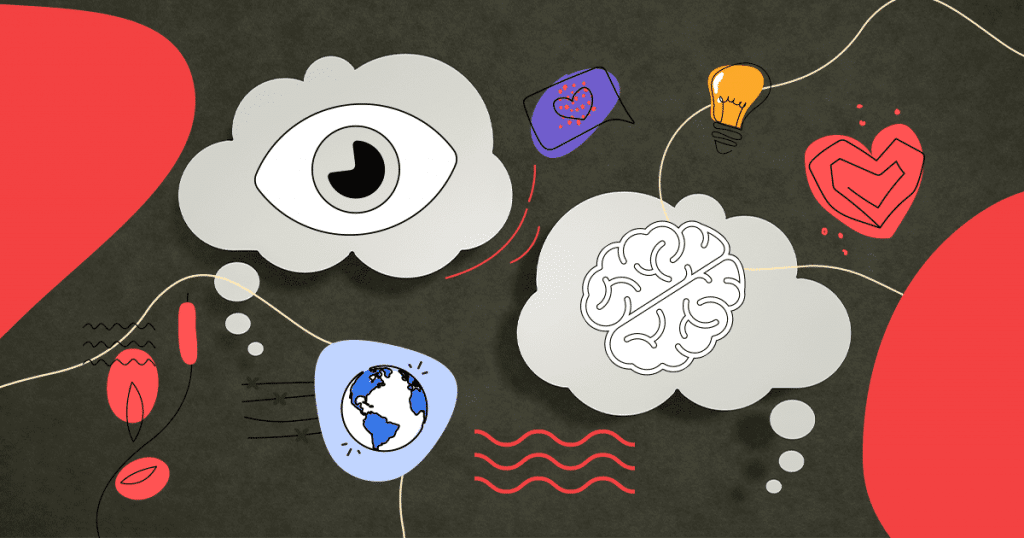What is visual language? To put it simply, it is a system that uses mostly images or symbols to convey meaning. Because of their patterns, the visuals can be understood by a large group of people.
This resource brings several benefits to businesses, such as helping to establish a strong brand identity. Thus, it helps your company to take things to the next level when it comes to brand differentiation.
But there is a lot more you need to know to really understand and be able to apply this concept.
Come with us to learn all about it, know how it can impact your business and how to develop a visual language according to your needs.
In this article, you will find out:
Download this post by entering your email below
What is visual language?
Visual language is a system that communicates through visual elements. It helps users perceive and understand visible signs.
A painting is an example of visual communication because your eyes perceive its signs (like shapes and colors) and your brain interprets them.
That way, to understand what is visual language, let’s take a look into semiotics first. This is the study of signs and symbols’ processing in human communication that considers the social and cultural background to explain their meanings.
Semiotics is helpful to comprehend how we create and interpret patterns in several communication systems. Then, it allows us to develop a system to deliver a specific message that can be easily understood by a group of people.
In the studies of this field, the sign is considered by Ferdinand de Saussure, a Swiss linguist, as the basic unit. According to him, it is composed of two parts that can never be apart from each other — signified (the concept) and signifier (what is used to convey meaning).
Think about the English language. Each word is associated with one or more meanings and all of its speakers know these signs. Besides that, there is a set of rules they must follow while using each sign. This is what allows them to successfully communicate with each other.
In a visual language, we also need patterns. So we can say that it is a set of signs and symbols that convey specific meanings using few or no words. That is, an image, a color, a symbol — alone or combined — must be associated with a concept.
Moreover, those signs must be able to express the intended message in a way that people who will receive it can get its meaning. In Marketing, that means you have to know your audience and create a consistent communication system.
What are the main benefits of visual language?
A visual language, as you already know, uses visual elements to express meaning. This is great for your business. Let’s find out why!
Consistency
When you create a visual language, your marketing campaigns become consistent. This allows your audience to identify and associate each piece to your company.
It does not mean you have to insert the brand’s logo or name in all content pieces. It is enough to use the same style — colors, typography, type of image — and bring elements strongly associated with the brand.
If you manage to do that, the audience will be more likely to move down faster along the sales funnel. And why so? Because people will get all the messages you are delivering in each content and connect to them.
When we see an arched yellow “M” near something red, or simply two yellow arches, we immediately think about McDonald’s. The brand uses a color palette and typography that can be recognizable anywhere, and each visual content is based on that.
Check out the example below of a video marketing strategy. Everything is yellow, red and white. There are arches and curves all over the video, a train (that makes us think about speed) and french fries. All of these elements belong to McDonald’s “universe”.
The polemic separated arches were meant to stress the importance of social distancing during the COVID-19 pandemic in 2020. Even though this is the only element, we know that it is connected to the brand, because, again, it has consistency.
Effective connection with the audience
In the process to develop a visual language, the audience’s profile, preferences and perception of the brand are considered. Therefore, your visual content will be more effective to establish a connection with targeted people.
Having effective client communication helps you to build a solid relationship with the audience, improve your brand image — because it will increase transparency — and get information that is useful to enhance your products or services.
Strong brand identity
Because a visual language is consistent, it makes it easier for your audience to identify your company’s content and products when they see it. Therefore, it will help you to strengthen your brand identity.
That means all content will bring the same style, express the same values and associate them with your brand. So it is a great tool you can use to communicate what is important to your brand.
Take a look at Coca-Cola’s logo, for example. Regardless of the language you speak, if you see any of the logos below separately in a bottle or can, even without the word “Coca-Cola”, you will know which beverage is inside.
How to develop a visual language for business?
After discovering all these benefits, you are probably eager to know a few tips to design your company’s visual language, right? Here are ours.
1. Define a color palette
One of the most basic aspects of a visual language is the color palette. It is a tool to establish your brand identity. Remember McDonald’s — everyone who knows the brand will think about it when they see yellow, red and white.
To define your palette, pick the colors that suit your brand the most, helping to deliver your message. You can choose a dominant one and others to complement it. Just make sure to include elements using the colors of the palette in all your contents.
Apply the same palette on your website, logo, interactive data visualization or any other type of content you are going to use in your marketing strategy or presentations.
Heineken’s color palette, for example, has different shades of green, red and very light silver. Even in a visual that presents information on a report, the same colors are used.
2. Develop typography hierarchy
It is important to be consistent, but you should not use the same typography in all contents. Depending on the style you choose, the typography might not be appropriate for all types of content, making them hard to read.
Select a typeface family or multiple fonts. If you have text in your logo, pick a distinct font to create contrast and stand out. In a text, for example, differentiate the title and the body by using different fonts, styles and/or sizes.
Besides that, set clear rules about where to use each typeface — headlines, sub-headlines, body — and how to determine the size, weight, alignment and spacing. That will ensure consistency in your brand’s content.
Absolut Vodka explains in its style guide the fonts’ usage. There are a specific font, style and size for each section of a text.
3. Define an image style
The style of the images also helps to strengthen your brand identity and make it memorable. If you are going to use illustrations, try to apply similar characteristics — shapes, design — to different contents.
It is important that the visuals can be related even when they are not together. Thereby, when your audience has access to only one content, it will easily know that it belongs to your brand.
In the image below, you can see that Smashmallow keeps the same image style in diverse materials. The color palette is pretty varied but, with the support of design and typefaces, it succeeds in creating a particular visual language.
4. Create a brand style guide
The style guide presents everything that is to know about your brand — from purpose, values and mission to typography, colors, logo and images’ usage. In the style guide, make sure to explain all aspects of the typefaces that are going to be used. Also, define the color palette and establish the guidelines for logo usage.
Besides that, give examples of images that can be used, as well as what is not appropriate for the brand. Illustrate it, showing the style and explaining the ideas behind it. Remember to also set the tone and language.
Having a brand style guide, all content created for your marketing campaigns will be properly formatted and will follow the same visual language, which means, again, consistency and strong identity.
A visual language, which helps to communicate with your audience by using visuals, is important to ensure that your company’s content is consistent, to strengthen its identity and to facilitate products’ recognition. Given that, it is vital to develop a good and detailed one.
Wrap Up
A well-defined visual language is a powerful tool for businesses to enhance their brand identity, maintain consistency in their messaging, and establish effective connections with their audience.
By utilizing visual elements such as colors, typography, and imagery, companies can create a cohesive and recognizable brand presence that resonates with their target market.
A strong visual language not only adds consistency to marketing campaigns but also strengthens brand differentiation, enabling businesses to stand out from the competition.
If you’re ready to harness the potential of visual language for your business, WriterAccess is here to help.
Our content creation platform offers a diverse pool of talented designers, writers, editors and strategists who can assist you in developing compelling and visually engaging content that aligns with your brand’s visual language.
Sign up for our 14-day free trial and experience the benefits of WriterAccess firsthand. Don’t miss out on this opportunity to take your business to the next level.













